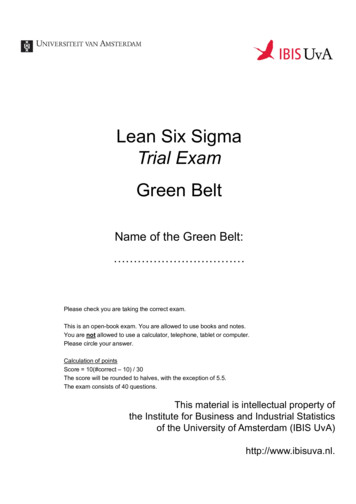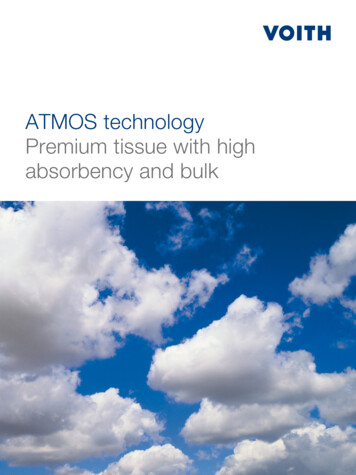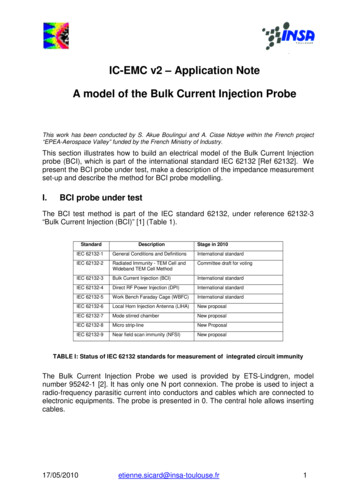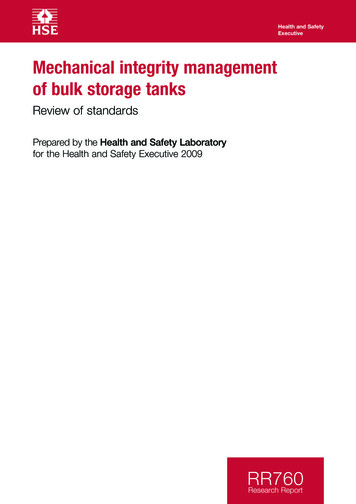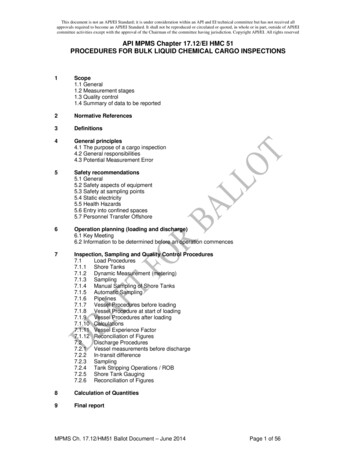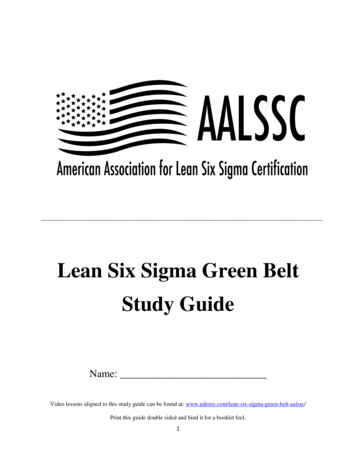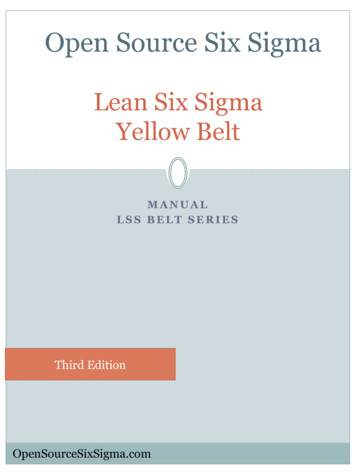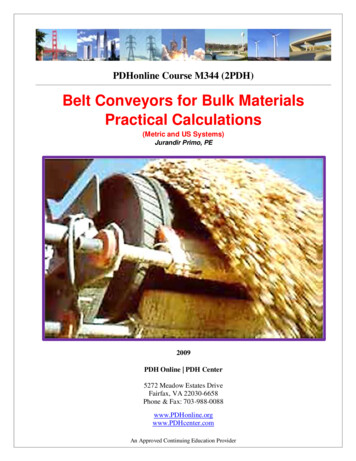
Transcription
PDHonline Course M344 (2PDH)Belt Conveyors for Bulk MaterialsPractical Calculations(Metric and US Systems)Jurandir Primo, PE2009PDH Online PDH Center5272 Meadow Estates DriveFairfax, VA 22030-6658Phone & Fax: 703-988-0088www.PDHonline.orgwww.PDHcenter.comAn Approved Continuing Education Provider
www.PDHcenter.comPDH Course M344www.PDHonline.orgCONTENTS:1. INTRODUCTION:2. BELT CHARACTERISTICS:3. BELT CONVEYORS - BASIC CALCULATIONS:4. CEMA BELT TENSION THEORY:5. TROUGHED BELT CONVEYOR CAPACITIES:6. BELT CARRYING IDLERS OR BELT TROUGHED ROLLERS:7. CEMA TROUGHED IDLERS:8. STANDARD BELT CONVEYOR PULLEYS:9. BELT CONVEYORS ACCESSORIES:10. BASIC DESIGN CRITERIA:11. LOADING OF BELT AND IMPACT ROLLERS:12. BELT CONVEYOR COVERS:13. BELT FABRICATION TYPES:14. INTERNATIONAL ISO STANDARDS:15. EASY SPREADSHEET CALCULATION TABLE:References: 2012 Jurandir PrimoPage 2 of 47
www.PDHcenter.comPDH Course M344www.PDHonline.orgBELT CONVEYORS FOR BULK MATERIALS1. INTRODUCTION:Belt conveyors consist of two powered pulleys with a continuous loop of belting material used to conveyproducts. Belt conveyors are the most economical powered conveyor and are typically used for conveyingproducts over long distances, at high speeds, or for incline/decline applications. This is done with endlessprocession of hooks, gears, buckets, and a wide rubber belt. The belt is then supported by a series ofrollers along the path.Belt conveyors are an excellent choice for an inexpensive and simple method of moving products fromone point to another. Because of the simplicity of the flat, moving belt, they can be used to move a varietyof product sizes, shapes and weights effectively for long lengths with a single drive. Belt Conveyors arealso a great option to move products through elevations. Incline Belt Conveyors from low to high andDecline Belt Conveyors from high to low.This manual is short, with quick and easy reading paragraphs, very practical for calculations of belt, chainconveyors and mechanical miscellaneous, in the metric and imperial system. The main function, however,is to give more informative methods for both experienced professionals and beginners interested inknowing the dynamics of Material Handling.Material handling equipment is mechanical equipment used for the movement, storage, control andprotection of materials, goods and products throughout the process of manufacturing, distribution,consumption and disposal.Material handling equipment include belt conveyors of several models and patterns, horizontal, vertical,inclined, declined, with chains or rollers, tube type, etc. Works in warehousing & distribution;manufacturing; order fulfillment; aerospace; government military & agency; automotive; parcel Handling;appliances; cabinetry & furniture; food & beverage.Note: In recent years, CEMA (Conveyor Equipment Manufacturers Association) and many membercompanies have developed computer programs capable of engineering analysis of the most complex andextensive process for belt and other material conveyor types. These programs are more comprehensiveand include more extensive analysis and calculations, not included in this short manual. 2012 Jurandir PrimoPage 3 of 47
www.PDHcenter.comPDH Course M344www.PDHonline.org2. BELT CHARACTERISTICS:There are a great range of belt conveyors specially manufactured to perform any carrying application andto surpass since a simple unit loading to tough conveying industrial conditions. See below some of the beltcharacteristics and special applications.a. Standard Rubber Belts: Standard belts incorporate covers suitable for the handling of most abrasive materialshaving a blend of natural and synthetic rubber.b. Cut Resistant Belts: Cut resistant belts have a high content of natural rubber, recommended for belts operatingunder extremely difficult conditions where cutting and gouging of covers may occur.c. Heat Resistant Belts: Heat Resistant belts incorporate covers with styrene butadiene, recommended for beltshandling materials with temperatures up to 1200 C.d. Super Heat Resistant Belts: Super Heat Resistant belts have Chlorobutyl covers, recommended for belts handlingmaterials with temperatures of up to 1700 C.e. Fire Resistant Belts: Fire resistant belts are manufactured with covers containing neoprene with multi-plycarcass constructions to meet the maximum standards of safety in underground mines.f. Wood Handling Belts: These belts were especially developed non-staining for the timber industry compounded toprovide resistance to oil and resin.g. Concentrator Belts: Concentrator belts are uniquely applied at gold mine concentrators.h. PVC Solid Woven Belts: PVC solid woven belts also known as “Vinyplast” are manufactured with polyester andnylon with cotton soaked in armor of PVC and PVC coatings, developed to withstand theimpact, tear and abrasion as the requirements to meet the most stringent flame-resistantstandards.i. Food Quality Belts: Food quality belts are manufactured from non-toxic materials resistant to oils, fats andstaining to meet the hygiene requirements of the food processing industry.j. Nitrile Covered PVC Belts: 2012 Jurandir PrimoPage 4 of 47
www.PDHcenter.com PDH Course M344www.PDHonline.orgNitrile covered PVC belts were developed for application in mines where the danger of fireexists and also have properties of flame retardant, oil, abrasion and heat resistance.k. Steel cord Belts: Steel cord belts are generally manufactured for application in long distances conveyorsstiffened with a steel wire inserted within a high quality rubber in order to get exceptionaltraction load and material high impact.l. Fire Resistant Steel cord Belts: Fire resistant steel cords belts were developed with properties of self-extinguishing fire tooffer advantages in free maintenance operations and long life for conveyors situated in fierymines.m. Oil Resistant Belts: Oil resistant belts are manufactured to provide easily washable linings in nitrile, neopreneor synthetic rubber in all layers, allowing ease application in handling of materialscontaining vegetable oils and minerals.n. Chevron Standard Belts: Chevron standard belts are manufactured with steel tyre cords in a 'V shape at intervalsover the belt length. These belts are generally recommended for standard belting wheredifficult conditions are applied i.e. slag transportation.o. Corrugated Sidewall Belts: Corrugated sidewall belts are the most effective ways of elevating materials in a confinedspace, and less space requirements, no transfer point, low maintenance and big capacity,commonly used in cement plants, coal-fired power plants, ports, and chemical industry. 2012 Jurandir PrimoPage 5 of 47
www.PDHcenter.comPDH Course M344www.PDHonline.org3. BELT CONVEYORS - BASIC CALCULATIONS:1. Mass of the Load per Unit Length:Load per unit length. Given the production capacity Qt tph, the weight of the load per unit length(kg/m) – (lbs per ft) is calculated by:Wm 2000. Qt60 x vorWm 33.333.Qt (lb/ft)vQ 0.278.QtvorQ Qt (Kg/m)3.600 x v2. Belt Tensions:In order to find the maximum tension is necessary to calculate the effective tension, that is, the forcerequired to move the conveyor and the load at a constant speed. The calculation of the total tension isbased on a constant speed of the belt including the necessary basic conditions to overcome the frictionalresistance and tension forces. In a basic way the effective tension is composed of: The tension to move with an empty belt, Tx; The tension of move the load horizontally, Ty; The tension to increase or decrease the load, Tz; The tension to overcome the resistance of accessories, Tus; The tension to overcome the resistance of scrapers, Tuc.a. The total tension is:Te T x Ty Tz Tus Tuc b. The tension to move the empty belt is:Tx G x fx x Lc c. The tension to move the load horizontally is:Ty Q (Wm) x fy x LC d. The tension to lift the load is:Tz Q (Wm) x H e. The tension needed to overcome the resistance of the skirtboards, Tus:T us fs x Q (Wm) x Ls (Kg) or T us fs. Ls. hs² (lb) vxbf. The tension to overcome the resistance of scrapers, Tuc:T uc A x ρ x fc 2012 Jurandir PrimoPage 6 of 47
www.PDHcenter.comPDH Course M344www.PDHonline.orgg. Moving trippers require additional pulleys in the system and therefore add a new tension, TutT ut 0. 01. (do x T 1)Dt3. Belt Length Correction, Lc:Short belt conveyors require relatively more power to overcome the resistance to friction than long onesand therefore an adjustment is made to calculate the effective tension.LC L 70 m (metric)LC L 230 ft (imperial)Therefore, the belt length correction is:C LcLAll conveyors require an additional belt tension in order to allow the pulley to drive forward an effectivetension without slipping. In a case of a simple horizontal conveyor T1 is the sum of the effective tension Teand the slack side, the tension T2.T1 T e T2 For the inclined conveyor, additional tensions are induced dueto the mass of the belt on the slope.T 1 T e T 2 Th Minimum tension to prevent slipping, Tm:The relations between T 1 and T 2 are:T1 eθ T2So:T2 1. T e eθ - 1The fundamental equation is given by:(The Euler’s equation): T1 T2.e µ α where:T1 and T2 tight side and slack side tensions at the driving pulley;α wrap angle of the belt in radiation;e natural logarithmic (Naperian) base, 2.718;µ Friction factor. 2012 Jurandir PrimoPage 7 of 47
www.PDHcenter.comPDH Course M344www.PDHonline.orgConsidering the factor K to prevent slipping, T m, is:T m k x Te The minimum tension to prevent belt sag between two rolls, T s is:Ts Sf x (B Q) x ld The slope tension, T h is:Th B x H Table 1: Coefficient of friction (between driving pulley and belt of pulley lag):Table 2: Wrap factor k:The final driving power P is calculated with the following formulas:P T e x v (metric) and P Te x v (imperial)7533,000 2012 Jurandir PrimoPage 8 of 47
www.PDHcenter.comPDH Course M344www.PDHonline.orgTable 3 – m² - ft²SfSag factor(See Table)kg/m - lb/ft(See Table)TUnit tensionkg/m – lb/ftm - ftT1Maximum belt tensionacross full belt widthkg - lbsmm - inT2Slack side tensionkg - lbsTeEffective tensionkg - lbskg/m³- lb/ft³ThSlope tensionkg - lbsAContact area of scraperBBelt mass per unit lengthbWidth between skirt platesBcEdge DistanceCLength correctioncoefficientDMaterial DensityDtDiameter of pulleymm - inTmMinimum tension toprevent slippingkg - lbsdoDiameter of pulley bearingsmm - inTsMinimum tension tolimit sagkg - lbsfcFriction coefficient forscrapers(See Table)TuTension to overcomeresistance ofaccessorieskg - lbsfsFriction coefficient forskirtboards(See Table)T ucTension to overcomeresistance of scraperskg - lbsfxFriction coefficient forempty belt(See Table)T usTension to overcomeresistance ofskirtboardskg - lbsfyFriction coefficient forloaded belt(See Table)TxTension to move theempty beltkg - lbsGMass of moving parts –kg/m – lb/ft(See Table)TyHChange in elevation alongconveyor lengthm - ftTzhsdepth of the materialtouching the skirt boardldIdler spacing (carry idlers)kDrive factorLinWmTension to move theload horizontallyTension to lift (or lower)the loadMass of load per unitlengthkg – lbskg - lbskg/m - lb/ftm - ftWBelt width(See Table)WbBelt mass per unitlengthHorizontal length ofconveyorm - ftθAngle of wrap on thedrive radiansLcCorrected length ofconveyorm - ftρPressure of scraper onthe beltkg/m2 – lb/ft²LsLength of skirt boardm - ftτBelt capacity in ton perhourt/hr - tphPAbsorbed powerkW - HPβTrough angledegreeQMass of load per unit lengthkg/m – lb/ftαMaterial surchargeangledegreeQtBelt CapacitytphvBelt Speed 2012 Jurandir Primomm - inkg/m - lb/ftradiansm/s - fpmPage 9 of 47
www.PDHcenter.comPDH Course M344www.PDHonline.orgTable 4 – Material Characteristics:TypeSuggestedGradeBulk Density(t/m³)Bulk Density(lb/ft³)Angle nium sulphateNAN0,90562017Ammonium sulphate,MAN0,80501010Asbestos ore or rockVAN/M1,30812018Ashes, coal, dryMAN0,60372523Ashes, coal, wetMAN0,75472525Ashes, gas producer,MAN1,203028Bark, wood,NAN0,24153027Bauxite, ground, dryVAN/M1,10682018Bauxite, mine runVAN/M1,36852017BrickVAN/M1,761103027Calcium carbideMAN1,20752018Carbon black, pelletizedMAN0,352255Cement, PortlandNAN/PHR1,50942520Cement clinkerMAN/DHR1,36852518Chalk, lumpyMAN1,30811015Chalk, 100 mesh andunderMAN1,102528CharcoalMAN0,35222522Clay, calcinedMAN1,44902522Clay, finesMAN1,761102022Coal, anthracite, sizedNAN/PVC0,90561016Coal, bituminous, sizedNAN/PVC0,80502016Coke, petroleum, calcinedVAN/M0,64402020Concrete wetVAN/M2,201372418Copper oreVAN/M2,171352020Copper th, as dug, dryVAN/M1,20752020Earth, wet, with 36852520Granite, broken, el, pebblesVAN/M1,52951012Gypsum, dustMAN1,50942020MaterialFoundry sand, old sandcores 2012 Jurandir Primo7568Page 10 of 47
www.PDHcenter.comPDH Course M344www.PDHonline.orgIron ore, coarse crushedVAN/M3,001872018Iron ore, crushed fineVAN/M3,502182018Kaolin clay, 75mm andunderMAN1,00622019Lead oresMAN3,802371015Lime, hydratedNAN0,60372521Lime, pebbleMAN0,90561017Limestone, agricultural3mm and underMAN1,10681020Magnesium sulphateMAN1,10681015Manganese oreVAN/M2,151342520Mica, groundMAN0,22142023Phosphate, groundfertilizerMAN/OR/PVC0,802018Phosphate rock, broken,dryVAN/M2,002018Phosphate rock,pulverizedVAN/M2,102518Phosphate, triple superMAN/OR/PVC0,80502018Pyrites, pelletsVAN/M2,001251015Potash oreMAN1,30811015QuartzHA/SN/M1,36851015Rock, crushedHA/SN/M2,151342018Rubber, pelletsMAN0,80502022Sand, bank, dryVAN/M1,601002018Sand, foundry, 22SinterVAN/M/PHR1,801121015Slag, blast furnace,crushedVAM/PHR/DHR1,361010Sodium phosphateMAN0,90561016Sugar, granulatedNAGF0,83521015Sugar,
PDHonline Course M344 (2PDH) _ Belt Conveyors for Bulk Materials Practical Calculations (Metric and US Systems) Jurandir Primo, PE 2009 PDH Online PDH Center 5272 Meadow Estates Drive Fairfax, VA 22030-6658 Phone & Fax: 703-988-0088 www.PDHonline.org www.PDHcenter.com
